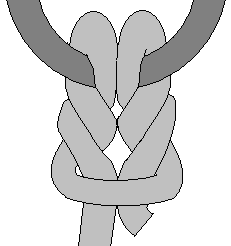m (W126jep moved page Adventist Youth Honors Answer Book/Knot/Cat's paw to AY Honors/Knot/Cat's paw without leaving a redirect: Part of translatable page "Adventist Youth Honors Answer Book/Knot/Cat's paw") |
|||
| (23 intermediate revisions by 4 users not shown) | |||
| Line 1: | Line 1: | ||
| − | + | <noinclude><translate><!--T:8--> | |
| + | </noinclude> | ||
| − | < | + | <!--T:9--> |
| + | {{ | ||
| − | + | <!--T:10--> | |
| − | + | Knot | |
| − | + | | name=Cat's paw | |
| − | = | + | | image= catspawknot.png |
| − | Cat | + | | use = The Cat's paw is used for connecting a rope to an object. |
| − | + | * Attaching a rope to a hook (or to a post or rail where the load is perpendicular to the post) with more security than a simple girth hitch. | |
| − | |||
| − | |||
| − | |||
| − | |||
| − | |||
| − | |||
| − | = | ||
| − | The | ||
| − | |||
| − | |||
| − | |||
| − | |||
| − | |||
| − | |||
| − | |||
| − | * Attaching a rope to a hook (or to a post or rail where the load is perpendicular to the post) with more security than a simple | ||
* Joining an eye to a ring. | * Joining an eye to a ring. | ||
* Strongly joining eyes in the ends of two lines, where there is access to the end of at least one line. | * Strongly joining eyes in the ends of two lines, where there is access to the end of at least one line. | ||
| + | | tying_instructions = | ||
| + | ;Method 1: | ||
| + | Form a bight in the middle of the line, and pull it back over itself like a girth hitch. This forms two loops, turned in opposite directions. Give each loop one more full turn in the direction that will tend to tighten it (the wrong direction will undo the loop completely). Pass both loops over the hook, rail or post and pull tight, taking care to push the bight up snugly against the turns. | ||
| + | ;Method 2: | ||
| + | If working end of the line has an eye in it, and the standing end is accessible, the knot can be tied to a closed ring, another eye, or a rail with inaccessible ends, as follows. Pass the eye around the ring or rail, then pass the standing end through its own eye (this effectively forms a girth hitch). Then pass the standing end through the eye again, and pull up tight, taking care to push the bight up snugly against the turns. | ||
| − | + | <!--T:3--> | |
| − | + | When using the cat's paw to join two eyes, this process may be repeated several times to give several turns - as many as five in a fine fishing monofilament. Then when tightened, instead of pulling the bight up against the turns, both eyes are pulled equally, to make neat coils of turns in both eyes, meeting halfway between them. | |
| − | |||
| − | |||
| − | |||
| − | |||
| − | |||
| − | |||
| − | |||
| − | |||
| − | |||
| − | |||
| − | |||
| − | |||
| − | |||
| − | |||
| − | |||
| − | |||
| − | |||
| − | When using the cat's paw to join two eyes, this process may be repeated several times to give several turns - as many as five in a fine fishing | ||
| − | + | <!--T:6--> | |
| + | }} | ||
| − | + | <!--T:7--> | |
| − | + | <noinclude></translate></noinclude> | |
Latest revision as of 15:05, 8 September 2021
| Cat's paw |
|---|
|
Use: The Cat's paw is used for connecting a rope to an object.
How to tie:
Form a bight in the middle of the line, and pull it back over itself like a girth hitch. This forms two loops, turned in opposite directions. Give each loop one more full turn in the direction that will tend to tighten it (the wrong direction will undo the loop completely). Pass both loops over the hook, rail or post and pull tight, taking care to push the bight up snugly against the turns.
If working end of the line has an eye in it, and the standing end is accessible, the knot can be tied to a closed ring, another eye, or a rail with inaccessible ends, as follows. Pass the eye around the ring or rail, then pass the standing end through its own eye (this effectively forms a girth hitch). Then pass the standing end through the eye again, and pull up tight, taking care to push the bight up snugly against the turns. When using the cat's paw to join two eyes, this process may be repeated several times to give several turns - as many as five in a fine fishing monofilament. Then when tightened, instead of pulling the bight up against the turns, both eyes are pulled equally, to make neat coils of turns in both eyes, meeting halfway between them. |

